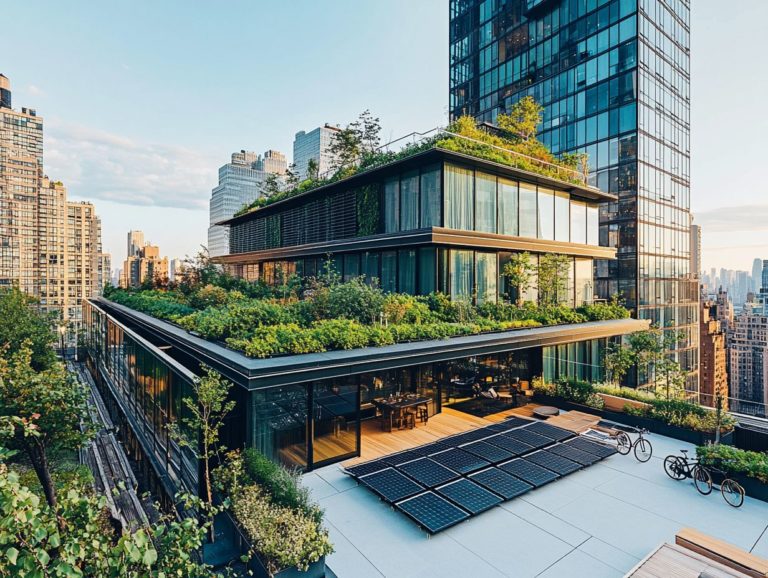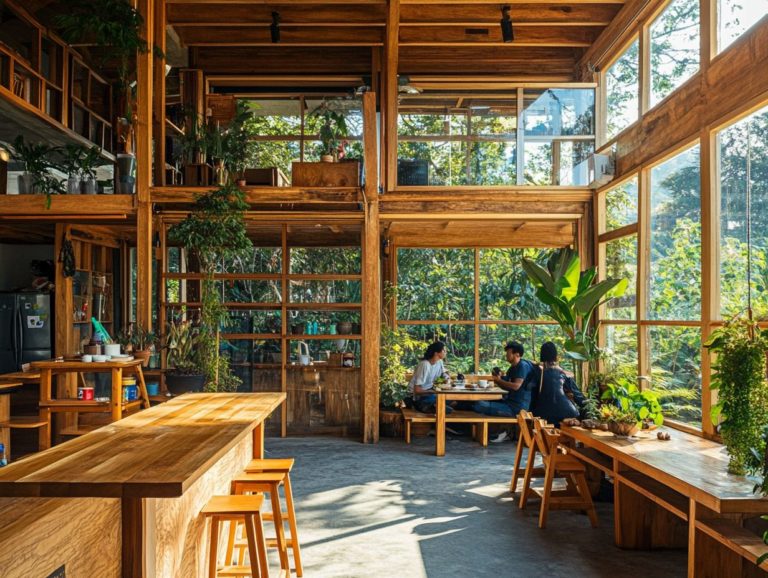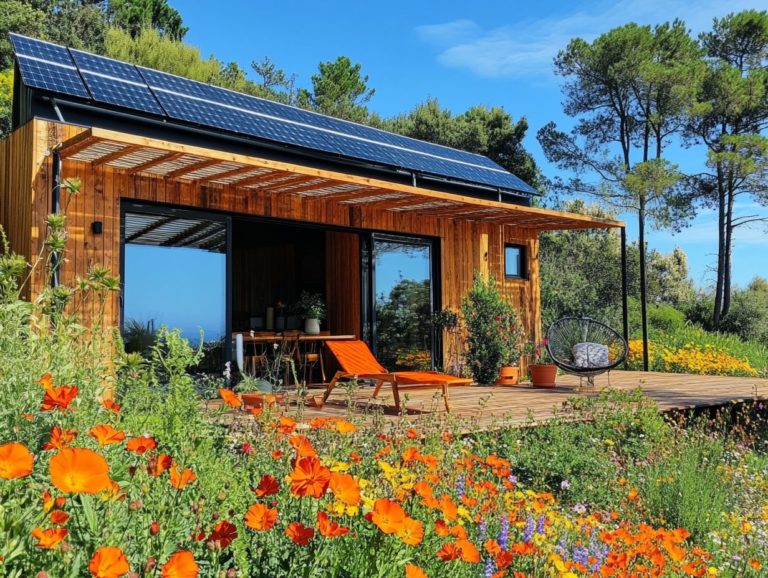Eco-Friendly Travel: Accommodations That Care
Bringing plants into your home can truly transform your living space in remarkable ways. They enhance air quality and uplift your mood, infusing a touch of nature into your decor.
Explore the myriad benefits of having plants at home, discover how to select the right ones for each room, and uncover essential tips for their care. You’ll find innovative ideas to seamlessly incorporate greenery into your interior design, making your space feel vibrant and inviting, while enhancing the overall plant aesthetics.
Take a step now to create a healthier and happier home with plants!
Contents
- Key Takeaways:
- Benefits of Having Plants in Your Home
- Choosing the Right Plants for Your Space
- Placement of Plants in Different Rooms
- Transform Your Living Room with These Stunning Plants!
- Ideal Plants for Bedrooms
- Recommended Plants for Bathrooms
- Caring for Your Indoor Plants
- Decorating with Plants
- Frequently Asked Questions
- What are some general tips for positioning plants in my home?
- What are some specific tips for positioning plants in different rooms?
- Can I position plants near windows?
- How should I position hanging plants?
- What if I don’t have a lot of natural light in my home?
- Are there any plants I should avoid positioning in my home?
Key Takeaways:
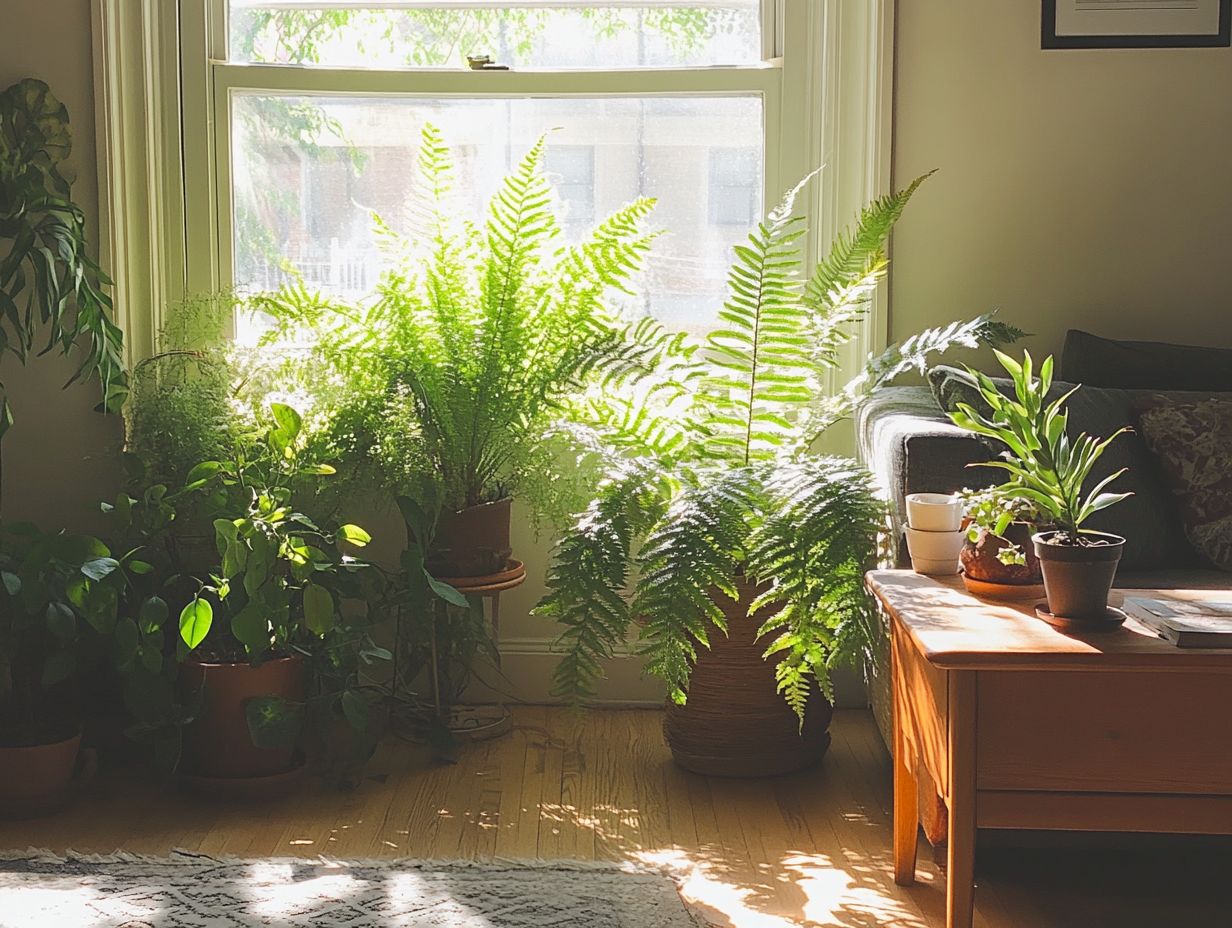
- Adding plants to your home can improve air quality and boost your mood.
- Consider lighting and space when selecting the right plants for your home.
- Place plants strategically in each room: living rooms benefit from air-purifying plants, bedrooms can benefit from calming plants, and bathrooms can benefit from plants that thrive in humidity.
Benefits of Having Plants in Your Home
Incorporating plants into your home, like houseplants, brings a wealth of benefits that elevate your living environment and personal well-being. From enhancing air quality to uplifting your mood, the presence of greenery is essential in cultivating a calming atmosphere.
Indoor gardening beautifies your space and encourages a healthier lifestyle with various plants that purify the air and promote tranquility. The aesthetic charm of vibrant colors and diverse heights can transform any room into a lush oasis. To learn more about incorporating greenery into your home, check out our guide on how to use indoor plants to brighten your home, making plants a crucial design element in home decor.
Improved Air Quality and Mood
Indoor plants, particularly those that purify the air, can significantly enhance your living environment. They make your home healthier and more enjoyable while uplifting your mood.
Among these botanical beauties, spider plants and pothos are visually appealing and excel at filtering out toxins like formaldehyde and benzene from the air. Research indicates that having indoor plants can reduce stress levels by a remarkable 37% and boost productivity by as much as 15%. The presence of greenery creates a sense of tranquility, leading to an overall improvement in well-being.
By welcoming these plants into your space, you ll breathe cleaner air and experience an uplifting boost in mood, making them critical companions in your home.
Choosing the Right Plants for Your Space
Selecting the ideal plants for your space involves a clear understanding of the specific light requirements, moisture levels, and care needs of various plant types.
Whether you lean toward low-maintenance options or are drawn to exquisite varieties that demand a bit more attention, making informed choices will elevate your environment beautifully.
Factors to Consider
When selecting plants, it’s crucial to consider their specific light requirements, moisture levels, and overall needs to ensure they thrive in your home.
If you have a sunny spot near a south-facing window, it’s perfect for bright sunlight lovers like succulents and cacti. They’ll bask in those warm rays and flourish. For those looking to optimize their plant care, exploring the best light arrangements for houseplants can make all the difference. In contrast, shadier corners are ideal for low-light tolerant varieties such as pothos and snake plants.
Don’t overlook humidity preferences; ferns and orchids crave a more humid environment, making them ideal for bathrooms or kitchens. Meanwhile, hardy plants like snake plants thrive in drier conditions.
By grasping these key factors and choosing plants that fit your home’s unique environment, you can cultivate a harmonious and thriving indoor garden, enhancing the visual weight of your decor.
Placement of Plants in Different Rooms
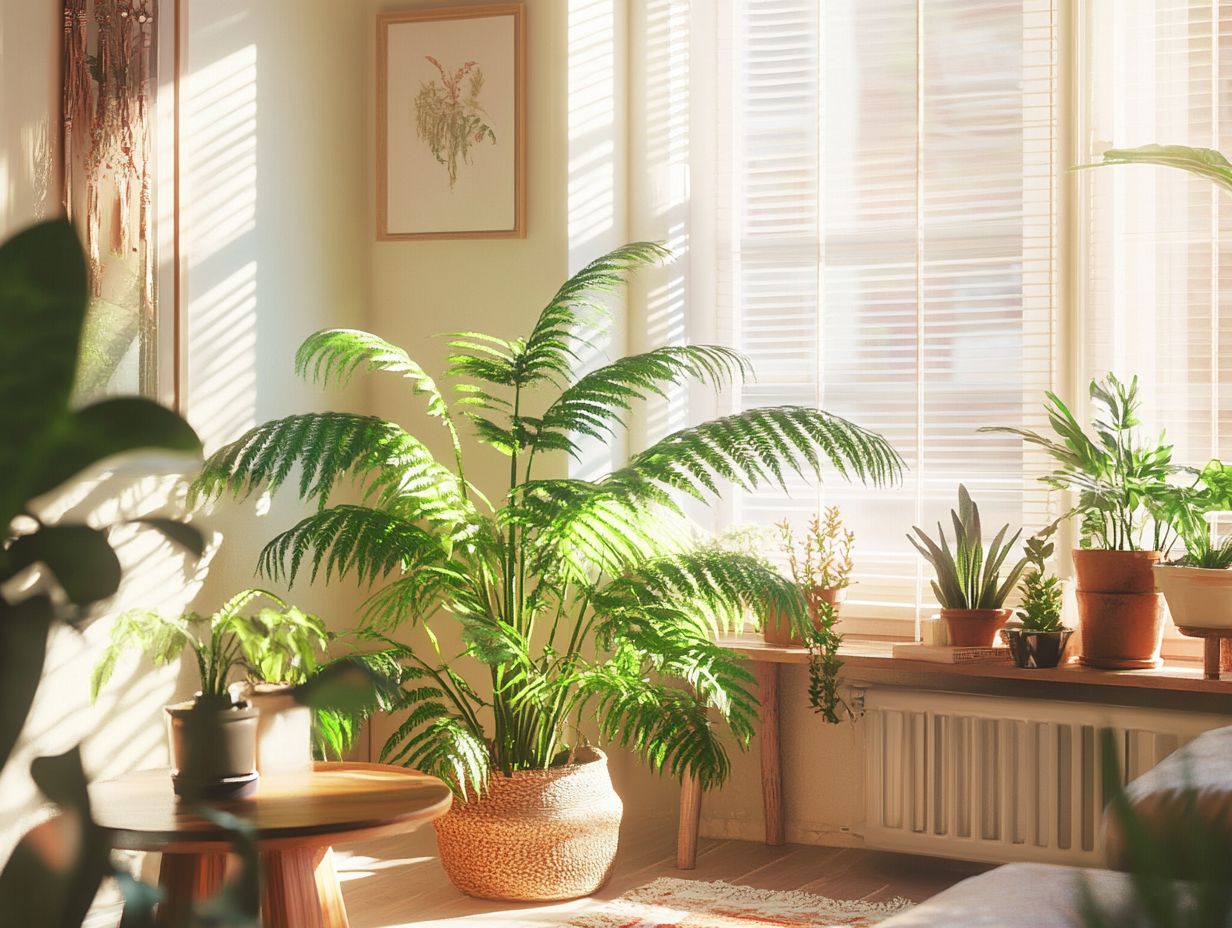
Strategic placement of indoor plants in various rooms can elevate both the aesthetic appeal and functionality of your home. Whether you aim to infuse your living room with vibrant energy, cultivate a serene atmosphere in your bedroom, or introduce refreshing greenery to your bathroom, thoughtful plant arrangement holds the key to transforming your space.
Transform Your Living Room with These Stunning Plants!
When you re selecting the perfect plants for your living room, think about incorporating tall plants and indoor trees that not only serve as striking decorative elements but also enhance your interior design.
Take snake plants, for example. They re easy to care for and thrive in various lighting conditions, making them suitable for both bright and dim spaces.
Then there are ficus trees, which add a dramatic flair with their sleek leaves and impressive heights. They serve as stunning focal points in any room!
For potting these beauties, choose decorative pots that elevate the overall aesthetic. Opt for ceramic or textured planters that seamlessly blend with your decor style.
By arranging these greenery pieces thoughtfully, you can transform your living area, adding visual interest and creating a refreshing atmosphere.
Ideal Plants for Bedrooms
Ideal bedroom plants do more than just elevate the aesthetics of your space; they also enhance air quality and regulate humidity. This creates a serene environment that fosters restful sleep and promotes well-being.
Among the finest choices, peace lilies truly shine with their graceful appearance and outstanding ability to filter toxins. They make an exquisite addition beside your nightstand!
These plants flourish even in low light and work wonders in boosting humidity levels, which can be a game changer for dry skin during those chilly months.
Lavender is another superb option, celebrated for its calming aroma that encourages relaxation. Position it on a sunny windowsill, where it can soak up the abundant light it craves.
Both of these plants require regular watering. Remember to let the soil dry out a bit between sessions to prevent the risk of overwatering.
Recommended Plants for Bathrooms
Bathroom plants thrive in the moist environment, making them a superb choice for adding greenery while accommodating low-light conditions and enhancing plant health.
This distinctive setting allows a diverse range of flora to thrive, particularly ferns and spider plants. Both of these plants naturally adapt to high moisture levels.
Ferns, with their lush, feathery leaves, absolutely revel in the humidity and can thrive even in the dimmer light often found in bathrooms. Spider plants are not just resilient; they re also celebrated for their air-purifying abilities.
To keep these botanical companions healthy, ensure they receive indirect sunlight and a gentle misting from time to time. It s also important to regularly check for overwatering, as standing water can lead to root rot, putting a damper on your green thumb ambitions.
Caring for Your Indoor Plants
Caring for your indoor plants requires a keen understanding of their individual watering needs, moisture levels, and the ideal potting mix to foster optimal health and growth. Each plant has its unique preferences, and recognizing these nuances is essential for nurturing a thriving indoor garden.
Watering and Sunlight Requirements
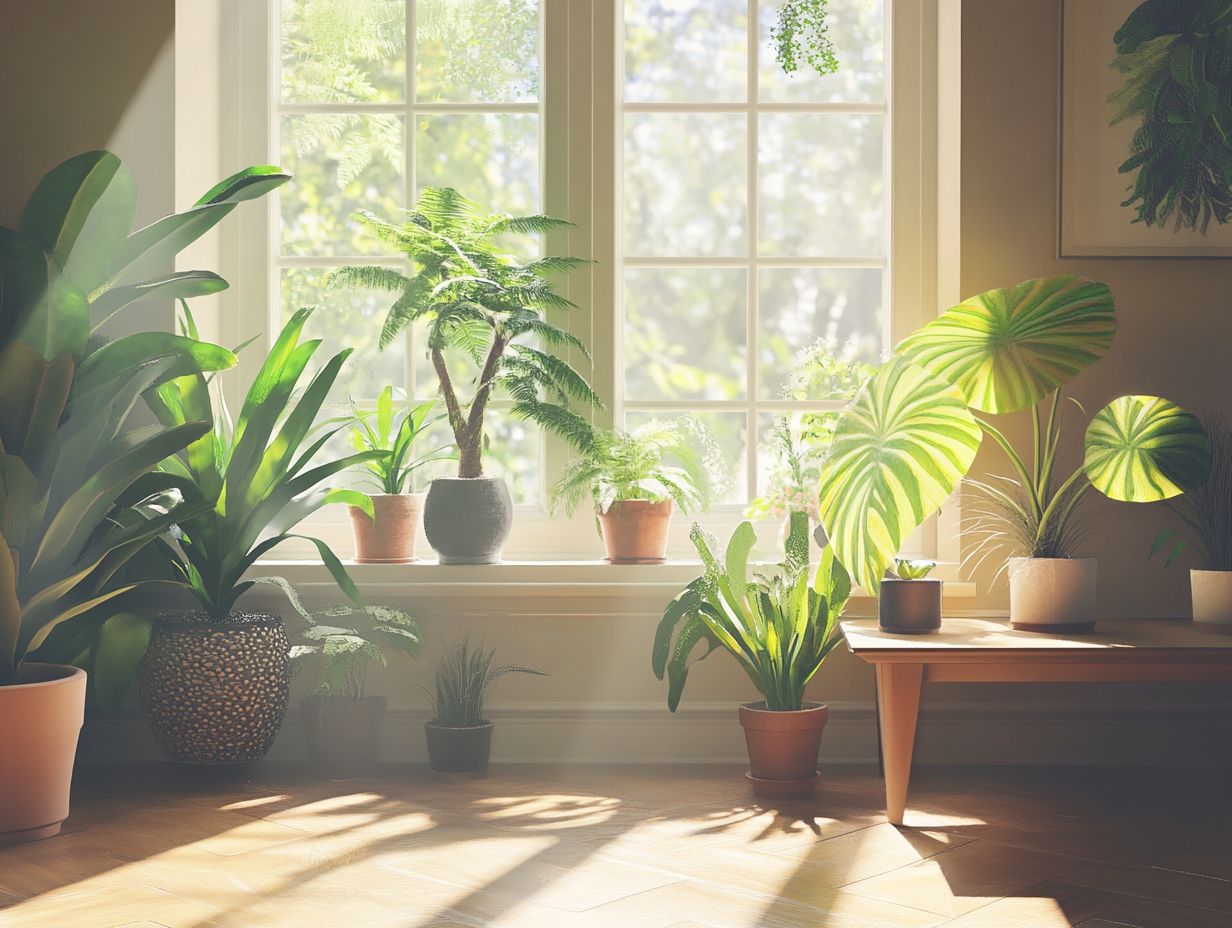
Understanding the watering and sunlight requirements of your houseplants is essential for ensuring their long-term health and vitality. Familiarizing yourself with these crucial factors helps create an environment that promotes robust growth while minimizing common issues like overwatering or sunburn.
Different species thrive under varied conditions. Some bask in bright, direct sunlight, while others prefer the gentle embrace of shaded or low-light scenarios. To enhance your space, consider incorporating indoor plant styling tips for every room. It’s imperative to observe how each plant responds to its environment.
Adjusting your watering frequency based on humidity levels and the season can truly make all the difference. To maintain their well-being, consider employing self-watering systems or moisture meters. Always pay attention to the quality of light they receive.
Regularly rotating pots will help ensure even growth, allowing the beauty of your green companions to shine through.
Start selecting your plants today for a healthier living space!
Common Plant Care Mistakes to Avoid
Avoiding plant care mistakes can boost the health and longevity of your houseplants. This ensures they thrive beautifully in your indoor space.
Many indoor gardeners create unsuitable environments for their plants. Issues like overwatering can lead to root rot, and ignoring light needs can cause leaf drop.
Neglecting feeding schedules can weaken your plants further. Understand your plants specific needs for water, light, and nutrients.
Check soil moisture regularly. Providing ample sunlight can transform your indoor garden into a flourishing oasis filled with colorful leaves!
Decorating with Plants
Decorating with plants can enhance your home decor. Thoughtful displays bring life and vibrant color, creating inviting spaces.
Incorporating Plants into Your Home Decor
Adding plants to your decor elevates a room s visual appeal. They infuse a touch of nature that enhances your interior design.
Choose striking large floor plants for bold statements or charming tabletop succulents for subtle enhancements. Decorative pots range from minimalist designs to vibrant patterns!
For a cohesive look, consider your room s color palette. Earthy tones complement warm or neutral interiors, while bright pots can create eye-catching contrasts.
Arranging plants of varying heights and textures adds depth and intrigue to your decor. It makes integrating greenery both effortless and intentional.
Frequently Asked Questions
What are some general tips for positioning plants in my home?

To help your plants thrive, place them in spots with proper lighting, temperature, and humidity. Avoid placing them near heating or cooling vents, and keep them away from drafts.
What are some specific tips for positioning plants in different rooms?
In living rooms or bedrooms, place plants where they can get plenty of natural light. In kitchens or bathrooms, look for plants that thrive in humid environments, like ferns or tropical plants.
Can I position plants near windows?
Yes! Windows provide essential natural light for plants. Just be careful of direct sunlight, which can be too intense. Use sheer curtains or position plants a few feet away from the window to avoid sunburn.
How should I position hanging plants?
Hanging plants can add visual interest and save space. Choose a sturdy hook or rod to support the weight of the plant. Consider the plant’s height and the space it will occupy when fully grown.
What if I don’t have a lot of natural light in my home?
If natural light is limited, opt for low-light varieties like snake plants or pothos. You can also use grow lights to supplement the lighting.
Are there any plants I should avoid positioning in my home?
Yes, steer clear of plants that are toxic to pets or children. Research any new plants before bringing them home. Common toxic plants include pothos, philodendron, and lilies.

